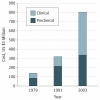Novel methods and technologies for 21st-century clinical trials: a review
- PMID: 25730665
- PMCID: PMC4708881
- DOI: 10.1001/jamaneurol.2014.4524
Novel methods and technologies for 21st-century clinical trials: a review
Abstract
Importance: New technologies are rapidly reshaping health care. However, their effect on drug development to date generally has been limited.
Objectives: To evaluate disease modeling and simulation, alternative study design, novel objective measures, virtual research visits, and enhanced participant engagement and to examine their potential effects as methods and tools on clinical trials.
Evidence review: We conducted a systematic search of relevant terms on PubMed (disease modeling and clinical trials; adaptive design, clinical trials, and neurology; Internet, clinical trials, and neurology; and telemedicine, clinical trials, and neurology), references of previous publications, and our files. The search encompassed articles published from January 1, 2000, through November 30, 2014, and produced 7976 articles, of which 22 were determined to be relevant and are included in this review.
Findings: Few of these new methods and technologies have been applied to neurology clinical trials. Clinical outcomes, including cognitive and stroke outcomes, increasingly are captured remotely. Other therapeutic areas have successfully implemented many of these tools and technologies, including web-enabled clinical trials.
Conclusions and relevance: Increased use of new tools and approaches in future clinical trials can enhance the design, improve the assessment, and engage participants in the evaluation of novel therapies for neurologic disorders.
Figures


References
-
- DiMasi JA, Grabowski HG. The cost of biopharmaceutical R&D: is biotech different? Manage Decis Econ. 2007;28(4-5):469–479.
-
- Paul SM, Mytelka DS, Dunwiddie CT, et al. How to improve R&D productivity: the pharmaceutical industry’s grand challenge. Nat Rev Drug Discov. 2010;9(3):203–214. - PubMed
-
- DiMasi JA, Hansen RW, Grabowski HG. The price of innovation: new estimates of drug development costs. J Health Econ. 2003;22(2):151–185. - PubMed
-
- US Food and Drug Administration . 2013 Novel New Drugs Summary. US Food and Drug Administration; Silver Spring, MD: 2014.
-
- Booth B, Zemmel R. Prospects for productivity. Nat Rev Drug Discov. 2004;3(5):451–456. - PubMed
Publication types
MeSH terms
Grants and funding
LinkOut - more resources
Full Text Sources
Other Literature Sources
Medical

